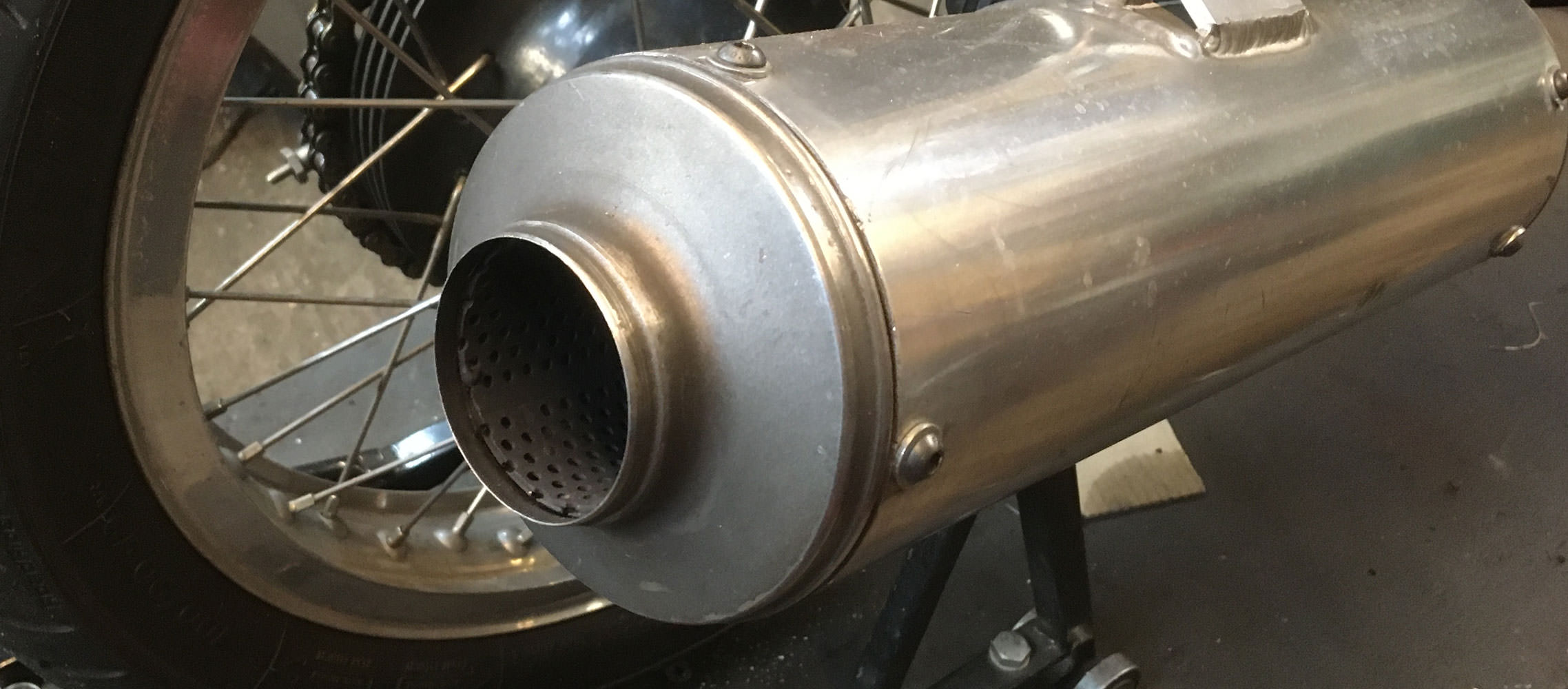
Yes, it is noise tests, i.e. plural, these days because you have to pass the ACU static noise test at 105dBA and most circuits also have a ‘drive-by’ system which you must pass as well. The drive-by systems measure the total noise generated as the race day progresses and can also pick out individual bikes that are over the limit as well. The circuits have agreements with their local council putting limits on the total noise usually measured in 30-minute chunks. However, do not panic; it is perfectly possible to pass both noise tests without too much trouble or noticeably affecting the performance of your bike.
Stuffing the silencer
Even if your silencer has passed through a 105 noise check in the past, have you checked the sound-absorbing wadding recently? We have found that in use the wadding gradually degrades and disappears presumably out of the perforated tube. We have also found that the wadding will also degrade without use if it is in a damp environment. So, unless you have just renewed the wadding, now is the time to do it. However, don’t go mad when packing the silencer as another thing we have discovered is that the efficiency of the silencer can be degraded if the stuffing is too tightly packed.
There are proper acoustic muffler packings that expand in use to fill the packing chamber to the correct density. Demon Tweeks list some and there are many other suppliers.
Making end caps for the silencer
The 500 Owners Association who race 500cc bike-engined cars ran into noise issues a few years ago. The most common engines are the JAP Speedway and Manx Norton engines, so their experience is directly applicable to our bikes.
Back in 2012 one of their members, an engineer Roy Hunt, undertook an extensive test programme to understand how noise levels in the 500s could be controlled, and those measures are still effective today. Roy and another member Mike Fowler conducted tests on a car with a ‘short stroke’ (86×86) Norton engine fitted with a more or less standard megaphone and absorption type silencer as used on classic race bikes. They found that the key was to add an end cap to the silencer which had a smaller hole than the silencer bore, which made the silencer more effective. In fact, the noise is almost directly proportional to outlet size, irrespective of silencer type.
Classic racing – keep the noise down
By adjusting the diameter of the hole, it is possible to adjust the amount of noise. They found that somewhere in the range 40-50mm as an output aperture can get the noise level down, but this seemed to make little difference to the power output of the engine. The diagrams show the two types of end cap that have been tried – neither seemed any better or worse, though the one with a tube is slightly harder to construct. They are held on to the silencer can with a large Jubilee clip, and in general these caps
reduce the noise output by about 2/3dB.
Richard Adams’ end caps
Subsequently, Richard Adams has made end caps based on the design in the right-hand diagram and found that his bikes go through the noise test at around 103 decibels (A-weighted decibels, or dBA). He is happy to give advice on making and using them. You can contact him on 01789 763153.
Jet engine techniques
Here is an idea which also works. Some of the latest commercial aircraft engines have a design feature on the jet pipe outlet called ‘chevrons’ that reduces the noise levels of the aircraft. This simple idea has been taken up by Stuart Hicken’s BSB Buildbase Suzuki Team and has been easy to construct and had very good results. The following video explains the principle behind the Buildbase Suzuki exhaust outlet.
Some points
- The smaller the diameter of the exhaust outlet, the lower the decibel level.
- The longer the absorption tube the lower the dBA level.
- The volume of the wadding chamber needs to be large enough for a decent amount of wadding to be used.
- Carbon exhaust sleeves record lower decibel levels than alloy.
- Proper acoustic wadding is more effective than loft insulation.
- Regular maintenance of the silencer is important.
- A warmed-up bike and silencer will pass the noise test more easily.
- If you richened the mixture to start the bike, make sure you have returned the mixture to the warm running setting.
- A good figure to aim for if possible is 103dBA which easily passes the ACU test and will pass the drive-by as well.
- It helps to mark your tacho with the target rpm and then concentrate of keeping to the mark.
- Don’t shout at the noise tester – they are doing their job and would much rather you passed than failed.
And finally…
I know it is a pain to go through all the palaver of noise testing, sorting silencers and so on and then having the stress of passing the noise test before getting out on track. It is perfectly possible to sort your silencing effectively and once you have it sorted and get through safely at around 103dBA the stress will evaporate. Then you can enjoy Lansdowne racing and getting together having a great time.





